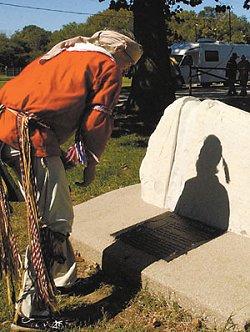|
By Bill Dotson, Danville Commercial News
Shirley Willard doesn’t dwell on discussing which of those involved in the 1838 Trail of Death were the good guys or the bad guys. “We won’t get into who was good or bad. The important thing is to remember and make sure it never happens again,” she said. Willard is secretary and editor for the Indian Awareness Center, a branch of the Fulton County (Ind.) Historical Society. Located in Rochester, Ind., near the trail’s starting point, the center is the official repository for all Trail of Death historical materials. Willard also serves as coordinator for the placement of historical markers on the trail. In 1988, she and George Godfrey of the Citizen Potawatomi Nation organized the first Trail of Death Commemorative Caravan. It marked the 150th anniversary of the 1838 forced removal of Potawatomi Indians from Indiana to Kansas. “Many died and were buried along the way, hence the name Trail of Death, as they traveled on foot and horseback,” Willard said. The 1988 caravan of cars and campers was greeted by many along the way. “They shared a spiritual experience and decided to make the trip again in five years,” Willard said. Willard and Godfrey organized commemorative caravans again in 1993, 1998 and this fall. Each trip consisted of visits to the historical markers at all the known original campsites along the way, including those in Warren County, Ind., and in Vermilion County, Ill. “It’s a sad chapter of local history but we’re honored to be a part of what they’re doing now,” said Warren County historian Marilyn Mann. In 1996, Philip High, then a-15-year-old freshman at Seeger Memorial High School, undertook his Eagle Scout project: the placement of the historical marker at Williamsport’s Old Town Park, one of the sites visited by the commemorative caravan. “I think Warren County has more history than most people even realize. Hopefully, this will help make people more aware of that,” he said. High said he learned a lot from that project, including that the Potawatomi Trail of Death is not the same as the Trail of Tears, which refers to the Cherokee, though many people confuse the two. Hubert Powell and Paul Quick of Danville erected the Ellsworth Park marker in Danville in 1990. Powell told Willard last week that he made it crooked intentionally. “I did that because it was such a crooked deal that they did to the Indians back then,” he said. This year, six new historical markers were erected, for a final total of 74, to complete the marking of the Trail of Death, Willard said. “It may be the best marked historic trail in the U.S., maybe the world,” she said. “Our next project is to publish a big folding highway map that shows the location of all the markers.” Willard says the completion of marking the trail is important for what it signifies. “We live in a new century and today, people are trying to right the wrongs of the past,” she said. “History cannot be changed but people’s attitudes can be changed.” “All this is an indication that the time is fast approaching when the American Indians will be treated with respect and equality so that they may have true freedom,” Willard said. “That is our wish.” |
| < Previous | Home | Next > |
